Appendix 1: Foundation Programs 2011-2014 summaries and outcomes
1. THE TARDIS PROGRAM: TRACKING ANCIENT RESIDUES DISTRIBUTED IN THE SILICATE EARTH
Themes 2 and 3, Earth Evolution and Earth Today, contributing to understanding Earth’s Architecture and Fluid Fluxes.
AIMS:
The main goals of the TARDIS program are (1) to define the initial composition and evolution of Earth’s convecting mantle using the Re-Os isotopic systematics of platinum-group minerals and sulfides from ophiolites and komatiites; (2) to understand the origins of ophiolitic chromitites; (3) to understand the osmium isotope heterogeneity observed in samples from the convective mantle, and how this heterogeneity may reflect major events in Earth’s evolution; and (4) to evaluate the evidence for the preservation of large volumes of ancient continental mantle within the ocean basins.
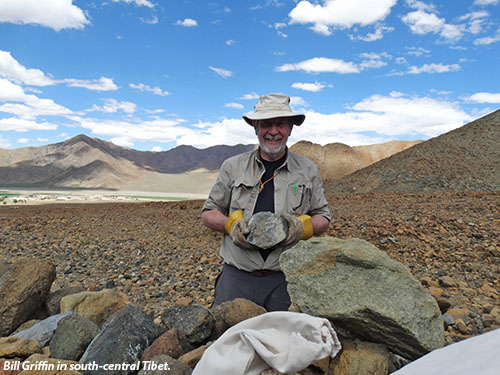 FINAL REPORT 2011-2014:
FINAL REPORT 2011-2014:
A synthesis of existing and new data on the early crust (U-Pb, Hf, O isotopes) and the cratonic subcontinental lithospheric mantle (SCLM) using primarily Re-Os data, shows that no SCLM can be detected prior to a 3.5 Ga, leading to an entirely new model of SCLM formation (Griffin et al, 2013 ), and hence continent stabilisation, mainly driven by major mantle overturns between 3.3-2.8 Ga.
Extensive studies of Platinum Group minerals (PGM) in ophiolitic chromitites have produced a novel model for chromitite formation. This has been sequentially developed in 14 papers, culminating in two major review papers (see Outputs). We demonstrated that most ophiolitic peridotites carry evidence of an original continentalparentage, and represent pre-existing lithospheric mantle, the partial melting residues of ancient convecting mantle. This new finding has led to a better understanding of the behaviour of the Re-Os systematics of ophiolites and their chromitites; this in turn allows a more sophisticated interpretation of Os isotope data, which will provide a robust foundation for the second stage of this program.
A major discovery (Gonzalez-Jimenez et al. 2012 ) was the high degree of mobility of the PGEs, including Os and Ir, during high temperature UHP metamorphism, which contrasts with traditional ideas that view Os as immobile, thus changing interpretations of Re-Os data. Another high-impact outcome was the identification of a group of Archean-heritage buoyant continental microcontinents that are the likely reason the Mediterranean basin has not closed (Gonzalez-Jimenez et al. 2013).
An integrated study of the eclogite xenolith suite from the Roberts Victor kimberlite, South Africa (relevant to unravelling potential mantle fingerprints of subduction processes) has overturned an existing paradigm. Two PhD theses demonstrated that the major element, trace element and isotopic (Sr, Nd, Hf, O) compositions of the dominant Group I eclogites (and their diamonds) are the products of extensive, young mantle metasomatism, while the rare Group II eclogites are probably ancient mantle cumulates, and the protoliths to Group I. There is thus no evidence in these rocks that can support an origin as subducted ocean floor. These two PhD projects showed that the “evidence” used to demonstrate a subducted origin of the eclogites is not diagnostic.
A series of studies on crust-mantle linkages beneath various parts of China (including several PhD projects) has continued our construction of an overall history for the SCLM beneath eastern China, providing insights pertinent to our growing interest in continental collisions.
OUTCOMES AND IMPACT:
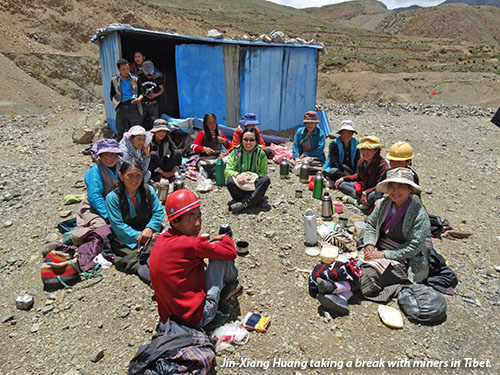
We have demonstrated the Archean origin of most SCLM, and its genesis between 3.5-2.7 Ga; the lack of SCLM “roots” to stabilise continents before this time explains the rarity of Hadean crust. This has resulted in new geologically realistic parameters for geodynamic models.
We have demonstrated the major control that SCLM structure exerts on fluid pathways and hence the distribution of mineralisation in the crust; this campaign culminated in a recent invited article in Nature Geoscience.
Our work has challenged traditional concepts that ophiolites are dominantly formed at ocean floor spreading centres, assembling components derived from the convecting mantle. Instead, the mantle components of many ophiolites have ancient subcontinental lithospheric mantle heritage.
The SuR-UHP (Super-Reducing-Ultra High Pressure) environment has been newly recognised and the requirement for its derivation from the Transition Zone promises to change the framework for understanding subduction regimes, related tectonic processes and geodynamic mechanisms.
Postgraduate students involved:
Yoann Gréau, Jin-Xiang Huang, Nicole McGowan, Ed Saunders, Qing Xiong, Yao Yu, Romain Tilhac
Published outputs:
CCFS Publications #1, 2, 3, 4, 5, 7, 13, 14, 15, 36, 37, 38, 39, 41, 42, 65, 71, 75, 95, 161, 163, 179, 186, 190, 195, 197, 198, 199, 200, 202, 207, 213, 215, 221, 224, 250, 269, 270, 234, 235, 236, 237, 239, 281, 320, 324, 334, 344, 348, 349, 352, 361, 362, 358, 359, 362, 380, 390
2A. METAL SOURCES AND TRANSPORT MECHANISMS IN THE DEEP LITHOSPHERE
Theme 3, Earth Today, contributing to understanding Earth’s Architecture and Fluid Fluxes.
AIMS:
This program was designed to: (1) provide new knowledge on the character and behaviour of Earth fluids, such as silicate and sulfide melts, brines, vapours, hydrocarbons, supercritical fluids, at the P-T conditions of the lithospheric mantle-asthenosphere; and (2) unravel the complex transport and concentration mechanisms of siderophile-chalcophile elements such as Ni,
Cu and PGE in the deep lithosphere.

FINAL REPORT 2011-2014:
New experiments have been performed on H2O-saturated basanite compositions that extend the range of investigated conditions from 0.5 to 4.0 GPa and 950 to 1200° C. The experiments reveal that most incompatible elements and chalcophile metals become increasingly soluble in H2O-fluids at high temperatures and pressures, with the attainment of complete miscibility between H2O-fluids and basanitic melts at 4.0 GPa and 1100° C. Experiments have also been conducted on both dry and H2O-undersaturated mixes for the purpose of determining the composition of the H2O-saturated fluids coexisting with basanite melt, as well as the solubility of H2O in the melt. These experiments are ongoing and are part of a completed study of H2O partitioning between peridotite minerals and basanite melt. In combination, these studies provide important information about the likely distribution and compositional characteristics of H2O-rich fluids in the Earth’s mantle and lower lithosphere. They also provide the basis for more advanced experimental studies on S-bearing aqueous fluids under mantle conditions that are planned in the upcoming Flagship Program.
In terms of fieldwork, several field seasons have been successfully completed since the commencement of this program in 2011, with Leon Bagas and Jochen Kolb working closely with the Geological Survey of Denmark and Greenland (GEUS) in Greenland, and Marco Fiorentini, Marek Locmelis, Tracy Rushmer, Steve Reddy and John Adam - together with collaborators in various institutions worldwide - in the Ivrea Zone (IVZ), northwest Italy (Fig. 1). These studies have elucidated the size, geometry and nature of deep Ni-Cu-PGE mineralised intrusions, shedding new light on ore-forming processes at the crucial interface between lithospheric mantle and lower continental crust. These field studies were complemented by a series of targeted analytical programs, which have started to unravel the complex chemical and isotopic evolution of these magmatic systems. These data were subsequently integrated with 3D micro-tomography and EBSD studies (Fig. 2) to constrain the physical processes that favour the transport and concentration of sulfide liquids in deep lithospheric settings. These results are currently being written up for publication.
Figure 1. Steve Barnes and Wolf Maier on the mantle peridotite outcrop in Balmuccia (Ivrea Zone, Italy) during a brain storming field trip organised by CI Marco Fiorentini in May 2014. The puzzling question is the link between the pyroxenite veins that cross-cut the outcrop and the occurrence of mineralised intrusions in the overlying mafic underplated stratigraphy.
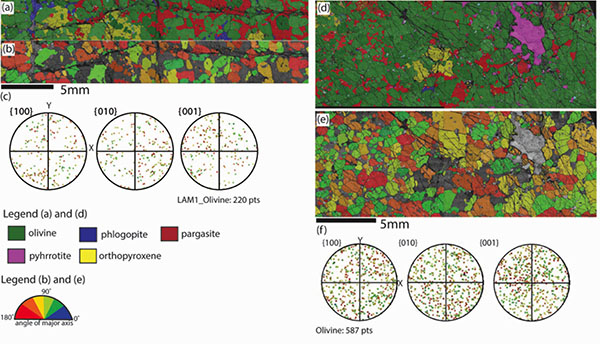
OUTCOMES AND IMPACT:
Within the framework of this program, cross-node interaction was extremely fruitful and successful. Researchers from all CCFS nodes carried out joint field activities and collaborated at various levels, as demonstrated from the high number of co-authored publications. Genuine cross-node collaboration was essential because the wide range of expertise that was necessary to attain the challenging goals of the program was not present at any single one of the CCFS nodes but could be gained from a combination of all of them. A measure of the successful interaction is the fact that the same researchers want to keep working together and design ambitious new studies that build on the outcomes of this Foundation Program.
Figure 2. Large area, EBSD maps from samples coming from the centre (a- c) and (d-f) margin of a mineralised ultramafic pipe. Maps a, d show presence and distribution of 5 main phases (see legend). Grain shape EBSD maps show orientation of the long axis of the fitted ellipsoid within the crystal (b and e). Angle of the long axis can be from 0 to 180° (blue to red colour). Pole figure data of olivine crystals (point per grain) is shown on (c) and (f) from the pipe centre and pipe margin respectively. Point colour matches the colour of the olivine crystals from the respective grain shape maps. Data is shown on the equal area projection of the lower hemisphere.
Postgraduate students involved:
Peter Keolleger, Ellen Davies, John Owen, Celia Guergouz, Steve Rennick, Brendan Lally
Published outputs:
CCFS Publications #32, 162, 174, 222, 228, 272, 277, 310, 333, 335, 389, 413, 419, 447, 448
2B. DYNAMICS OF EARTH’S MANTLE: ASSESSING THE RELATIVES ROLES OF DEFORMATION AND MAGMATISM
Theme 2, Earth Evolution, contributing to understanding Earth’s Architecture.
AIMS:
Understanding mantle dynamics is key to understanding plate tectonics. This program aims to provide new constraints on the nature of mantle deformation in different tectonic environments by exploring the microstructural and geochemical relationships between fluids and/or melts during upper mantle deformation associated with rift initiation, continental margin formation and subduction.
FINAL REPORT 2011-2014:
Mantle deformation has been studied by direct analysis of both peridotite massifs and xenolith samples from a range of different localities. This work has focused on two major aspects of mantle deformation:
1) the role of fluids in controlling the operation of different slip systems, as evidenced by the intragrain microstructures and bulk fabric;
2) the detailed characterisation of mantle deformation associated with melt percolation during rifting and hyper-extensional mantle uplift.
The work has required a detailed analysis of the relationships between intragrain slip systems and bulk fabrics that has provided some fundamental new insights into deformation of mantle materials and the evolution of different fabric types in different tectonic environments. These results are currently being written up for publication and have led to new insights into the role of mantle deformation in controlling supra-subduction zone seismic anisotropy and has led to us questioning the relative roles of mantle and slab in controlling trench-parallel seismic fast directions in forearc environments. Microstructural data of blueschists and high-pressure serpentinites from exhumed slabs confirm the need to consider the slab component of seismic anisotropy in forearc environments. Erin Gray’s results also show a relationship amongst crystal plasticity, microcrack development and advective fluid flow in the mantle. Similar approaches have been adopted in the study of mantle extension associated with continental rifting and continental margins. These confirm the activation of the E-type slip-system and provide the first evidence of [001] slip in such an environment. We show that decompression and cooling from high-pressure/high-temperature during rifting is the major factor influencing the localisation of deformation and the change in the dominant slip direction in olivine. Our work on exhumed Alpine peridotites also shows the importance of spatially variable melt percolation in strain localisation in the mantle during hyper-extensional thinning.
OUTCOMES AND IMPACT:
Results of this program on the microstructural state of the mantle in arc environments has led to questioning common models for trench-parallel fast seismic directions. The effect of the slab components in fore-arc environments needs to be considered in more detail. Microstructural studies have identified the mechanism that causes the first slip in rift environments. Melt percolation in the mantle has been show to cause strong localisation of strain.
Postgraduate students involved:
Erin Gray, Jed Bridges, Tram Do, Mathew van Rensburg
Published outputs:
CCFS Publication #335
3. GENERATING AND STABILISING THE EARLIEST CONTINENTAL LITHOSPHERE - LARGE GRANITE BLOOMS
Theme 2, Earth Evolution, contributing to understanding Earth’s Architecture and Fluid Fluxes.
AIMS:
This Foundation Program aimed to understand the genesis and stabilisation of the earliest continental lithosphere and the generation of giant Archean granite blooms, and also to constrain the nature and origin of the oldest preserved crust, as well as the mantle beneath cratonic areas and adjacent Proterozoic terrains. In doing so, it develops and applies new isotopic systems to supplement the use of zircons as tracers of crustal and mantle processes
FINAL REPORT 2011-2014:
The program aimed to understand the genesis of the earliest continental lithosphere, including the processes of fluid/melt extraction that stabilise, and thus preserve, Archean cratonic lithosphere. This involves isotopic studies of zircons from ancient terrains and deep-crustal xenoliths worldwide to further constrain the nature of the oldest preserved crust, and a continued search for the oldest mantle samples beneath cratonic areas. Targeted studies involving a regional characterisation of the 3.1 Ga Mpuluzi batholith (Swaziland/RSA) provide a basis for exploring the processes involved in the formation of stable crustal blocks in the Archean.
Collaborators in this program include Professor Alfred Kroener (Mainz and Beijing), a world-recognised expert on Precambrian geology, particularly in southern Africa. This incorporates the PhD project of Rosanna Murphy, who began in 2011 with Alfred Kroener as an external supervisor.
This program has close linkages with the research of Future Fellow Dr Elena Belousova (Research Highlight p. 64-65). This involves regional surveys (TerraneChron® approach) of zircons (U-Pb, Hf isotopes, O isotopes) from old continental areas, to pick up the signatures of the oldest crust. The program also studies zircons from deep crustal and mantle xenoliths in basaltic and kimberlitic rocks, and from the ultramafic-mafic Noril’sk-1 intrusion in Polar Siberia (Russia) to look deeper into the lithosphere. This work will be integrated with Os-isotope analysis of sulfides in mantle xenoliths (see TARDIS program) to define the origins of the subcontinental lithospheric mantle beneath the old areas where ancient crust is identified, and constrain the role of the mantle lithosphere in stabilising ancient crust.
OUTCOMES AND IMPACT:
The huge volumes of the Mpuluzi batholith were emplaced in a single magmatic episode from 3.17-3.10 Ga. The Mpuluzi magmas show a shift to more mafic compositions over time, suggesting that the compositional variation within the batholith was driven by a change in the degree of partial melting. Sr-Nd-Hf isotopic data demonstrate that the source region included older crust (>3.5 Ga), which constrains the tectonic setting and suggests that the high-degree melts of the lower crust were generated from an older crust, implying the input of enormous amounts of mantle heat, probably related to a mantle overturn. This probably depleted the lower crust in fusible components and established the first subcontinental mantle, leaving this area quiescent for 1.5 Ga.
Studies of material from super-deep drill cores in the Volgo-Uralia region of the East European Craton demonstrated the presence of unexpectedly ancient crust that was later reworked in an analogue to the Swaziland area. Together, these studies give us a picture of processes common to the evolution of the early Archean crust.
A major synthesis of evidence from crust and mantle rocks suggests that most sub-continental lithosphere was generated in a relatively short period around 3-3.5 Ga ago, probably through major mantle overturns. This process stabilised the cratons, providing “life-rafts” on which crustal rocks could be protected from destruction.
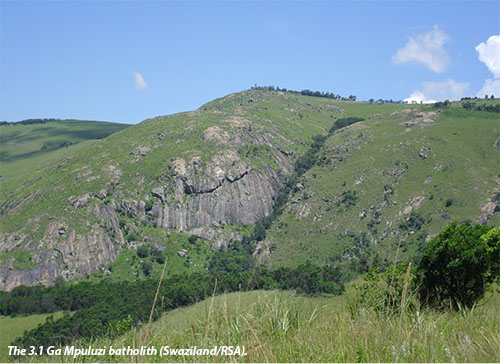
A study of zircons from kimberlites and crustal xenoliths across the Siberian Craton has mapped both the modification of the Archean crust during the Proterozoic assembly of the craton, and the presence of Archean crust and mantle beneath areas with Proterozoic upper crust. This finding requires a re-evaluation of diamond potential in the eastern Siberian craton.
Techniques have been developed for the analysis of Li isotopes, providing another tracer of magma sources and evolution. This work demonstrated that 6Li and 7Li are fractionated during post-crystallisational uptake of Li into magmatic zircons, and outlined the precautions required for robust interpretation of Li-isotope data.
The processes that disturb U-Pb systematics during metamictisation of U-rich zircons have been defined, producing a “recipe” for recognising zircons whose U-Pb systematics cannot be trusted. This should improve the overall quality of detrital zircon datasets.
Postgraduate students involved:
Rosanna Murphy, Yuya Gao, Irina Tretiakova
Published outputs:
CCFS Publications #12, 97, 130, 163, 194, 205, 213, 215, 214, 233, 235, 256, 280, 311, 313, 319, 330, 344, 394, 454, 470, 481, 492, 519, 613
4. TWO-PHASE FLOW WITHIN EARTH’S MANTLE: MODELLING, IMAGING AND APPLICATION TO FLAT SUBDUCTION SETTINGS
Theme 3, Earth Today, contributing to understanding Earth’s Architecture and Fluid Fluxes.
AIMS:
The overarching goal of this program is the development and application of in-house, state-of-the-art computational tools to simulate and image complex geochemical-geodynamic processes involving two-phase reactive flow in multi-component deformable media. These tools, in combination with advanced seismic imaging techniques, will be applied to the problem of fluid transport from shallow dipping to flat subduction settings, in both the western USA and South China in the past.
FINAL REPORT 2011-2014:
A new smooth particle hydrodynamic code (SPH) to study early planetary evolution and two-component fluid flow problems has been developed. The code has been parallelised in OpenMP, allowing it to be run on traditional supercomputers, in CUDA for GPU processors, and also for Xeon-Phi processors, allowing it to run on the next generation of supercomputing hardware - one of the few modern geodynamics codes with this capability. The code will be hosted at www.ccfs.mq.edu.au/SPH
The next generation of whole-Earth mantle convection simulation tools, based on the community code Aspect, has been developed. Postdoctoral researcher Siqi Zhang has led the development of Aspect modules to handle the next generation of big science problems, including refining physical models for materials under high-pressure conditions (e.g. Peierls-flow mechanisms), developing work-flows to handle the incorporation of gplates plate motion data into global simulations, incorporating melting and multi-component flow, including crustal remixing, into the code. This also incorporates the effects of impacts and re-coding the boundary conditions to handle the problem of core-evolution. This has given CCFS a numerical capacity to handle whole-Earth evolutionary problems not matched anywhere in the world.
The development of a two-phase multi-component reactive flow software platform for mantle processes is completed and benchmarked for the case of viscous rheologies. A two-phase model for micro-textural evolution using non-equilibrium thermodynamics has also been completed and we are using it to study the evolution of trace elements in magmas and of U-series systematics.
Through collaboration with the Institute of Geodesy and Geophysics (Chinese Academy of Sciences), China University of Geoscience (Beijing), we obtained data from the Chinese Seismic Network to construct higher resolution lithospheric structures in northeast and south China using an innovative seismic tomography method including Ambient Noise Tomography and Two-Plane Wave Tomography. Several papers have been published on the lithospheric structures.
Research Assistant, Mr Zhen Guo is working on the origin of intraplate volcanism in NE China and its possible relationship with the subducting Pacific slab by seismically imaging the fine structures of crust and upper mantle in NE China.
OUTCOMES AND IMPACT:
The major legacy outcomes were outlined in the preceding section. The impact of the program can be measured by numerous invited papers and keynote conference presentations. Code development underpinned a major research direction into the dynamics of the Hadean Earth, leading to a series of papers including invited papers in “Research Frontiers” (EPSL), American Journal of Science, and a Geological Society of London Special Publication. Other related invited contributions appeared in Comparative Climatology of Terrestrial Planets, the Australian Journal of Earth Science, an invited chapter in Arc-continent collision, and an invited chapter in the bookIntegrated Imaging of the Earth.
Numerous keynote and invited talks have been presented at international conferences including the 34th International Geological Congress, Brisbane (2012); the Australian Space Science Convention, Sydney; the Geological Society of America Annual Meeting, Denver, (2013); the American Geophysical Union Fall Meeting, San Francisco; theGoldschmidt Conference 2013, Florence; and the European Geosciences Union 2013, Vienna.
Yingjie Yang was awarded the prestigious Anton Hales Medal by the Australian Academy of Science, 2014, and Juan Carlos Afonso was awarded the EGU Division Outstanding Young Scientist in 2013 for integrated studies of the rheology and physical properties of the lithosphere.
PhD student Beñat Oliveira Bravo has been awarded the most prestigious Spanish postgraduate award “la Caixa”. Grants cover the full cost of matriculation, travel expenses and monthly allowances that can be extended up to 24 months. The award ceremony will take place in Barcelona, the 10th of April 2015, in the presence of the King and Queen of Spain.
Postgraduate students involved:
Beñat Oliveira-Bravo, Chris Grose, Elyse Schinella, Cara Danis, Rajat Taneja, Jonathon Wasiliev, Shahid Ramzan, Samuel Matthews, Chengxin Jiang.
Published output:
CCFS Publications #17, 20, 35, 165, 196, 217, 218, 237, 315, 318, 325, 330, 331, 340, 344, 414, 440, 442, 444, 450, 477, 488, 493, 506, 522, 578, 608
5. EARLY EVOLUTION OF THE EARTH SYSTEM AND THE FIRST LIFE FROM MULTIPLE SULFUR ISOTOPES
Theme 1, Early Earth, contributing to understanding Earth’s Fluid Fluxes.
AIMS:
The main aims of this Foundation Program were to define the nature of the first life in the early Archean and links between the early evolution of life and the rise of atmospheric oxygen in the Neoarchean. This will help to understand the evolution of the Earth’s oceanic and atmospheric composition during the Archean and Paleoproterozoic, and to evaluate the links between the evolution of the sulfur cycle and the formation of important Archean submarine ore deposits.
FINAL REPORT 2011-2014:
The three main aims were investigated in three research streams: CCFS post-doc David Wacey, and CIs Mark Barley and Martin Van Kranendonk focused on establishing the nature of early life, whereas CI Van Kranendonk was active in documenting the evolution of Earth’s oceanic and atmospheric composition together with a host of colleagues. AI Marco Fiorentini and PhD student Carissa Isaac focused on the sulfur cycle and the formation of Archean ore deposit systems. Ongoing investigations are documenting the S-isotope signature of volcanic massive sulfide (VMS) systems in Western Australia.
Highlights from the work on establishing the nature of the first life in the early Archean include the discovery and documentation of ecosystems of bacteria in ~3.5 billion-year-old rocks from Western Australia, and documenting that even this very first foothold of life may have included diverse microbial communities in differing habitats. CCFS researchers also put forward a new hypothesis that the volcanic rock, pumice, may have provided the ideal environment in which life could have evolved, and followed this up with a detailed study of some of Earth’s oldest pumice deposits from the ~3.5 Ga Apex Basalt of Western Australia (CCFS publication #232 ). Additional research identified consortia of 2.3 Ga and 1.9 Ga microfossils from rocks from the Hamersley region of Western Australia, and around Lake Superior, Canada, the former showing evidence for a sulfuretum in deep water conditions and the latter providing the first ever snapshot of organisms eating each other. Both suggest that previously unknown types of microbial metabolisms existed on the ancient Earth.
Research on the evolution of the Earth’s oceanic and atmospheric composition through the Precambrian led to some important new insights. A study on S-isotopic variation across the rise in atmospheric oxygen from the Paleoproterozoic succession of Western Australia identified the largest ever recorded swing in δ34S isotopic compositions and the rise of seawater sulfate concentrations (CCFS publication #93 ). CI Van Kranendonk and colleagues’ compilation of geotectonic and biogeological data across the Precambrian revealed long-wavelength cyclical changes in atmospheric composition tied to the supercontinent cycle, whereby periods of rapid crust formation immediately preceding supercontinent amalgamation events were followed by precipitation of banded iron-formations during the dénouement of the supercontinent cycle. These were followed, in turn, by periods of widespread (or even global) glaciation as the supercontinent cycle restarted (CCFS publication #152 ). A climax in the orogenic cycle at c. 1.1 Ga showed that the supercontinent cycle was evolving through time (CCFS publication #22 ). With associated changes in the biosphere linked to these geological changes through a successive, causative series of events tied to mantle dynamics, this study will form the conceptual basis for the new FP4.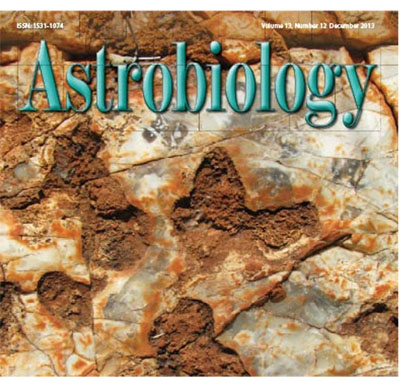
Figure 1. Chips of microbial mat within 3.5 billion-year-old rocks from Western Australia (front cover of the journal ‘Astrobiology’, December 2013).
Outcomes from the work on evaluating the links between the evolution of the sulfur cycle and the formation of komatiite hosted ore deposits have led researchers to identify sulfur dioxide degassing from komatiite volcanoes as a single process (Isaac et al., abst. 2013 ) that explains two major heretofore unrelated conundrums about the Archean earth system: (1) why are komatiite-hosted nickel deposits so well endowed?; (2) why did the values of mass-independent S isotopes suddenly expand 200 million years before the Great Oxidation Event? This new discovery provides a solid geologically based hypothesis for the bloom in S-MIF at 2.7 Ga that contrasts with model-based suggestions of changing CH4/O2 ratios at this time (Kurzweil et al., 2013 ).
OUTCOMES AND IMPACT:
The three key aims of Foundation Program 5 (FP5) have been fulfilled, as shown in the extensive publication record from 2011-2014 in a wide range of highly prestigious journals. Investigations into early life led to the discovery that previously unknown types of microbial metabolisms existed on the ancient Earth. Sulfur isotope studies have led to the discovery of the largest known isotope variations, and cycles in these can be linked to the formation and destruction of supercontinents. Studies of komatiite-hosted ore deposits have resulted in a solid hypothesis for the formation of these deposits in the time before the Great Oxidation Event.
Postgraduate students involved:
Carissa Isaac, Tara Djokic
Published outputs:
CCFS Publications #21, 22, 74, 86, 93, 104, 106, 107, 124, 136, 152, 157, 182, 183, 229, 230, 231, 232, 268, 321, 329, 349, 365, 378, 381, 421, 475, 484, 485, 527, 557, 599, 601
6. DETECTING EARTH’S RHYTHMS: AUSTRALIA’S PROTEROZOIC RECORD IN A GLOBAL CONTEXT
Theme 2, Earth Evolution, contributing to understanding Earth’s Architecture and Fluid Fluxes.
AIMS:
Through investigation of the age, petrogenesis and palaeomagnetic signature of targeted Australian Paleoproterozoic mafic igneous rocks, we aimed to establish the position(s) of the Australian cratonic blocks in the supercontinent Nuna, and to examine whether the evolution of Nuna was also accompanied by plume/superplume events.
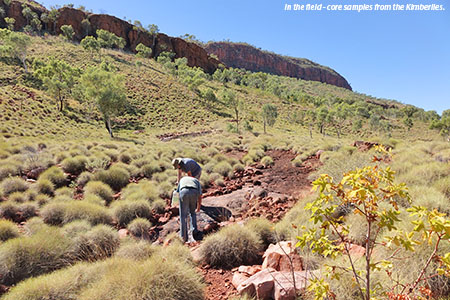
FINAL REPORT 2011-2014:
This Foundation Program has made a number of scientific breakthroughs in the past 3 years. These include publications on the first palaeomagnetically constrained configuration of the pre-Rodinia supercontinent Nuna (CCFS publications #197, 309 ), the recognition of a 40° rotation within the Australian craton during the Neoproterozoic that has fundamental implications in terms of the formation of the Australian continent, the configuration and timing of breakup of Rodinia, and the driving mechanism for Snowball Earth events (CCFS publications #117, 314 ).
A new key pole at age 1.2 Ga for the West Australia craton has been identified, which helps to define the transition between supercontinents Nuna and Rodinia (CCFS publication #309), and a new 1.2 Ga Large Igneous Province event in Australia has been documented (CCFS publication #371 ).
A young Hainan plume sourced from an ancient, lower-mantle reservoir has been discovered, the formation of which was likely linked to surrounding subduction zones (CCFS publications #24, 336 ). This mechanism is consistent with that published previously by our group (Li et al., 2008; Li and Zhong, 2009 ).
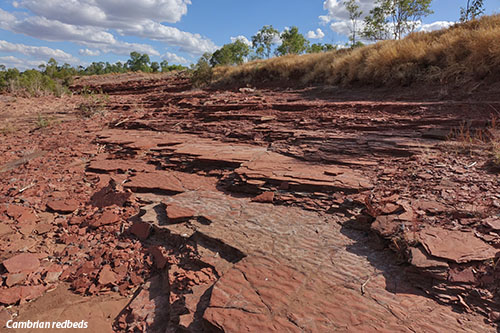
A new model explaining the collision of South China with northern India after the breakup of Rodinia but during the assembly of Gondwanaland has been conceived and published. This explains early Palaeozoic orogenic and basin record in both northern India and South China (CCFS publication #366 ).
OUTCOMES AND IMPACT:
69 refereed papers and one book have been published, including a large proportion of papers in high-impact journals such as Geology, Earth and Planetary Science Letters, Journal of Petrology, and Precambrian Research. The high impact of the research results is also shown by the high numbers of citations the group’s work has received, the organisation of conferences on related themes, numerous invited/keynote talks, and the co-editing of three journal special issues/book series by leading researchers Li and Pisarevsky. In addition, we published a series of papers on lithospheric tectonic processes and regional tectonic studies, including work in Tibet (CCFS publications #223, 496 ), NW China and South China.
Postgraduate students involved:
Huiqing Huang, Kongyang Zhu, Weihua Yao, Chong Pang, Ni Tao, Li-Ping Liu, Yingchao Liu, Lifeng Meng
Published outputs:
CCFS Publications #24, 32, 39, 179, 186, 195, 197, 221, 223, 224, 250, 269, 270, 278, 293, 297, 299, 300, 302, 307, 309, 314, 336, 353, 354, 366, 371, 386, 387, 422, 496
7. FLUID REGIMES AND THE COMPOSITION OF THE EARLY EARTH
Theme 1, Early Earth, contributing to understanding Earth’s Architecture and Fluid Fluxes.
AIMS:
This two-part program aimed to characterise the earliest crust on Earth and minerals and related fluids phases in extra-terrestrial samples. An objective was to identify new localities where ancient crust may still be preserved by working on both newly-discovered and existing samples of ancient zircon and acquiring full geochemical and isotopic data, so as to compare these with the huge inventory already obtained from Jack Hills and Mt Narryer. The aim was to identify any changes that may have taken place from the formation of the earliest zircons (4.4 Ga) to the time when crust was widely preserved. Conditions on the early Earth were compared with those in the early solar system represented by Martian meteorites, enabling characterisation of any fluid present and identifying primitive mantle deformation mechanisms and processes.
FINAL REPORT 2011-2014:
Areas of preserved ancient crust in Antarctica, Canada, China, Greenland, India, and Western Australia were identified as localities for in-depth study.
Zircon grains from ultra-high temperature rocks of the Napier Complex, Antarctica, were examined using the novel technique of ion imaging by Cameca ims 1280 in Stockholm, using both single collector and multi-collector modes. Patchy distribution of Pb, unrelated to zoning or crystal imperfections, has the potential to affect the207Pb/206Pb age, since spurious Hadean ages can be generated from areas up to 5 nm in diameter. This has led to an explanation of the reverse discordance on concordia diagrams more commonly observed in SIMS analyses than by ICP-MS or TIMS.
Investigations of Ti in Napier Complex zircons also revealed a patchy distribution, which has important implications for Ti-in-zircon thermometry. The redistribution of Pb and Ti was further characterised utilising Raman spectroscopy and the Australian Synchrotron. It is attributed to the combined effects of high-grade metamorphic events at 2.8 and 2.5 Ga that affected the Napier Complex.
The first Atom Probe study of zircon, in association with Prof John Valley and others at Wisconsin-Madison, together with Cameca engineers, has led to the identification of Pb mobilisation on a nano-scale that is attributed to initial alpha recoil damage enhanced by subsequent high-grade metamorphism.
Martian meteorites (Zagami, Nakhla and ALH84001) were investigated in association with the Smithsonian Institute, the Johnson Space Centre Curation Office and the WA Museum. EBSD mapping of minerals showed slip orientations, indicating that clinopyroxene in the Nakhla meteorite has only been mildly shocked with an estimated peak pressure of ~20 GPa, suggesting that the observed deformation pre-dates the shock event. The Zagami meteorite also exhibits shock-related microtextures, including formation of melt pockets and plagioclase converted to maskelynite. This suggests the various systems could be related to both magmatic deformation and a shock event.
Antarctic meteorite sample ALH84001 contains Fe-Mg-Mn-Ca carbonates that are strongly zoned with Mn- and Ca-rich cores, passing outward toward more Fe- and Mg-rich rims. Apatite found in the Zagami sample from the WA museum shows complex microstructures in EBSD related to ductile deformation.
OUTCOMES AND IMPACT:
A re-investigation of ancient zircon in Ordovician volcanics of the North Qinling Orogenic Belt in Central China indicated a range in U-Pb ages from 3909 ± 45 Ma to 4080 ± 9 Ma and Hf crustal model ages up to 4.5 Ga. These Hf model ages are similar to the oldest components recorded from Jack Hills and establish this as another example of the earliest generation of continental crust on Earth, now buried in the basement of the North China Craton.
The first complete traverse across the Jack Hills Belt was completed as part of Qian Wang’s doctoral studies at Curtin University. Extensive SHRIMP and MC-ICP-MS zircon data were collected and reveal that only a few units are Proterozoic in age. Importantly, a secular change in Hf results is recorded through the Hadean, documenting extensive re-working of crust throughout the Archaean.
Martian meteorite NWA 7533 contains a zircon with an age of 4430 Ma. This is the first Martian meteorite known to contain zircon and its age establishes the early development of crust on Mars, similar in age to that of the Moon and Earth. The correlation of intra-grain δ18O variability in the zircon with the degree of radiation damage likely results from interaction of metamict domains with low-temperature fluid. It appears that mass-independent oxygen isotope fractionation in the Martian atmosphere was established as early as ~4.43 Ga.
Postgraduate students involved:
Qian Wang, Rongfeng Ge, Mingdao Sun, Shan Li
Published outputs:
CCFS Publications #278, 282, 301, 403, 404, 405, 406, 407, 408, 409, 412, 420, 426, 427, 428, 429, 430, 431, 432, 542, 548, 555, 608
8. DIAMOND GENESIS: CRACKING THE CODE FOR DEEP-EARTH PROCESSES
Theme 2, Earth Evolution, contributing to understanding Earth’s Fluid Fluxes.
AIMS:
The LAM-ICP-MS analysis of diamonds, developed at Macquarie, will be combined with other types of in situ data to define the nature and evolution of diamond-forming fluids. The causes of isotopic variability of carbon, oxygen, nitrogen and sulfur in diamond-forming fluids will be constrained: are these primary signatures, or do they reflect isotopic fractionation during diamond growth? We aim to understand the links between diamond formation and the redox state of the lithospheric and asthenospheric mantle, and to develop a new exploration and evaluation methodologies for kimberlites by defining the trace element signatures of mantle minerals that have been exposed to diamond-bearing fluids.
FINAL REPORT 2011-2014:
A PhD study of polycrystalline diamond rocks (diamondites; K. Rubanova completed 2013) defined the types of carbonatitic-silicic fluids involved, and the isotopic fractionation (C, O) that they undergo during crystallisation. A pioneering EBSD study demonstrated the influence of deformation on diamond recrystallisation, and confirmed that the initial grain-size of the diamondites is much larger than previously thought (CCFS publication #210 ). The present fine-grained aggregates reflect significant recrystallisation under directed stress.
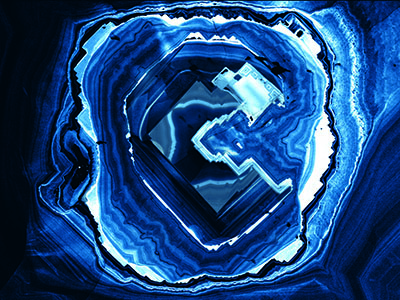
Dan Howell and Craig O’Neill developed software now available in the public domain that makes it possible to produce real maps of FTIR data, allowing the first integrated interpretations of CL, FTIR and chemical data in plates cut from diamonds.
Through a series of detailed studies combining this approach with SIMS analysis of C isotopes (CMCA, Perth), we have gained a better understanding of the growth mechanisms of diamond.
A major paper demonstrating the new model is in the final stages of preparation.
We have also become Chief Investigators in studies of the diamonds formed in super-reducing conditions in Tibetan ophiolites (project led by Dr J. Yang, CAGS, Beijing); this will be a major strand of the new integrated TARDIS-II program. There are 3 CCFS CIs on two Chinese projects [led by Prof J. Yang and R. Shi (Tibetan Plateau Research Unit, China Academy of Sciences)] with links to both the TARDIS and Diamond programs.
Dan Howell has played a significant role in the development of N isotopic methodology for SIMS analysis of N isotopes in diamond and development of relevant standards, firstly at Alberta, and later at CMCA (with John Cliff and Laure Martin).
False colour cathodoluminescence (CL) image of the core of a diamond cube from the Democratic Republic of Congo. While many natural diamond cubes are assumed to be of fibrous growth, detailed study has shown many contain cores of different diamond growth. Sometimes these cores are much older than the fibrous overgrowth. The cause of the blue CL are nitrogen defects within the diamond lattice. Image is approximately 1mm across.
This is one of the samples worked on in collaboration with Dr Masahiko Honda (CCFS AI, ANU RSES).
OUTCOMES AND IMPACT:
The demonstration of significant isotopic fractionation of C and O at UHP conditions has opened a new line of research, which will be pursued in the new integrated program. Through a series of studies, we have defined the trace element signature of a “universal mantle fluid” (probably a low-volume silico-carbonatite with varying alkali-element content) that is present in many styles of metasomatism, and is involved in the crystallisation of diamond. Differences from this “universal” pattern found in the Tibetan diamonds can be correlated with the SuR-UHP conditions. This recognition may be the key to a new approach to identifying “diamond fingerprints”; a project is being developed with Russian colleagues and Almazy (the Russian De Beers).
Systematic studies of diamond growth patterns have led to a new model of diamond growth, which differs significantly from the accepted paradigm; a paper is in preparation.
Postgraduate students involved:
Ekaterina Rubanova
Published outputs:
CCFS Publications #2, 6, 11, 52, 135, 168, 178, 180, 210, 211, 212, 236, 320, 332, 328, 372, 385, 502
9. 4D LITHOSPHERIC EVOLUTION AND CONTROLS ON MINERAL SYSTEM DISTRIBUTION: THE WESTERN SUPERIOR-YILGARN COMPARISON
Theme 2, Earth Evolution, contributing to understanding Earth’s Architecture.
AIMS:
The program aimed to provide a very well-constrained case study in an Archaean craton outside of the Yilgarn to (1) apply multi-isotopic (U-Pb, Lu-Hf, O) analyses in zircon to map deep lithospheric architecture in space and time, (2) determine if the distribution of mass and energy flow through the lithosphere as mapped by magma products and mineral systems (VMS, Fe, NiS, Au) shows strong control by this architecture, as it appears to in the Eastern Goldfields Superterrane of the Yilgarn Craton, and (3) generate mappable criteria for targeting exploration for various mineral systems at the craton to terrane scale. The Western Superior Province in Canada was initially selected for comparison due to the detailed geological information base available. This comparative study has since expanded to include Paleoproterozoic terranes of West Africa and the Northern Territory, and Cretaceous to Miocene terranes of Tibet.
FINAL REPORT 2011-2014:
This program is the first case study to obtain the full range of zircon multi-isotopic data and spatially map it over the Superior Province. Traditionally, researchers have taken isotopic and whole-rock geochemical data and presented them as a few data points in chart form. By contrast, we undertook an order of magnitude more analyses in order to effectively map the data spatially. A total of over 400 samples were collected for whole rock geochemical analyses and thin sections. Of these samples, 200 were selected for zircon U-Pb, Lu-Hf, and O isotope analyses, which is the largest and most complete such dataset in Superior Province collected to date. Results from the study have shown (1) that lithospheric architecture and its evolution in space and time can effectively be imaged by multi-isotopic zircon analyses, such that this approach can be used as a form of ‘paleogeophysics”, and can detect major ancient lithospheric boundaries NOT imaged in conventional crustal seismic and potential field geophysical surveys, (2) that the first-order whole-lithosphere architecture appears to be established early and reactivated through time, and (3) that the lithospheric architecture imaged by the isotopic maps yield strong control on the location of mineral systems in all terranes studied. This study has resulted in the request by mineral exploration companies to have this research applied in their exploration programs, illustrating the relevance to mineral exploration targeting recognised by industry. This program has initiated successful collaboration and leveraged research funding from China and Canada. The novel approach of this program is now being actively applied in other parts of the world, which places CCFS as the world leader in applying multi-isotopic mapping globally.
OUTCOMES AND IMPACT:
The concept and methodology of this program has subsequently been adopted by other groups in the world, in collaboration with CCFS, to understand the lithospheric architecture. Examples are Tibet and the Uchi/North Caribou terrane in Canada. This program has forged stronger collaborations and leverages with the Chinese Academy of Geological Sciences (CAGS), Lakehead University and the Ontario Geological Survey. The study has attracted significant interest from industry such that several exploration companies are incorporating the results into their exploration strategies (Western Superior, West Africa), the West African mapping will be expanded through an industry-funded research initiative with AMIRA, and a project has now been set up with one of the world’s largest gold companies to undertake this isotopic mapping in the Andes.
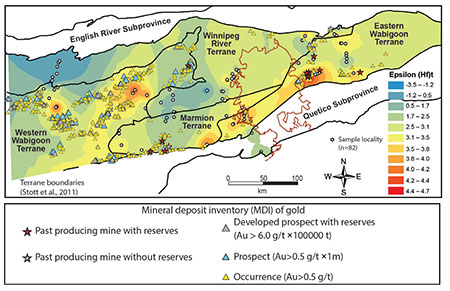
This interest shows how the program has demonstrated the potential to cause a paradigm shift in exploration strategy within the mineral industry by understanding the spatial and temporal evolution of whole-lithospheric architecture to aid area selection on the large scale. The program also squarely placed CCFS at the forefront of applicationof this science to mineral exploration globally.
Zircon Hf-isotope mapping of the Wabigoon Subprovince with revised terrane boundaries after Stott, OGS, 2011. The contour bar shows the Epsilon Hf value of zircons studied. The rectangles labeled 1 and 2 highlight the two gold camps in Eastern Wabigoon and the Marmion terrane, respectively. The most economic gold mineralisation discovered to date is represented by red and grey stars. See CCFS Research Highlight (2013), Zircon signposts for Gold.
Postgraduate students involved:
Katarina Bjorkman, Luis Parra-Avila, David Stevenson, Linda Iaccheri
Published outputs:
CCFS Publications #23, 32, 100, 162, 167, 170, 185, 206, 222, 243, 253, 255, 257, 258, 259, 260, 273, 346, 350, 382, 383, 452, 456, 457, 467, 494, 503, 517, 521, 530, 582
10A. 3D ARCHITECTURE OF THE WESTERN YILGARN CRATON
Theme 2 and 3, Earth Evolution and Earth Today, contributing to understanding Earth’s Architecture.
AIMS:
This program aimed to integrate new and existing data into a 4-dimensional, integrated model of crustal evolution for the western Yilgarn Craton, and to derive a better understanding of the mineralisation processes for this region, how the crust links to underlying lithospheric mantle, and what relationships this piece of lithosphere has with the more highly endowed Eastern Goldfields Superterrane in the eastern part of the craton.
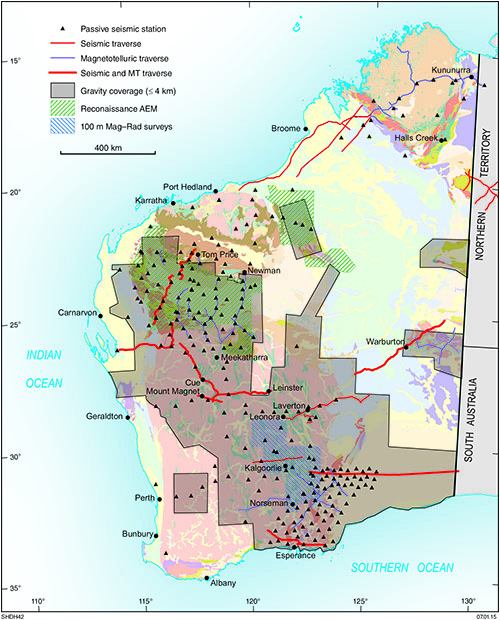
FINAL REPORT 2011-2014:
Significant steps have been taken to address crustal evolution of the western Yilgarn Craton, including the release of the Youanmi and South Carnarvon deep seismic reflection survey results, the planning and deployment of passive seismic arrays, and targeted geological field work.
Three individual seismic lines (YU1, YU2 and YU3) cross the northern part of the Yilgarn Craton from the Narryer Terrane in the northwest, across major bounding and internal structures of the Youanmi Terrane and into the Kalgoorlie Terrane of the Eastern Goldfields Superterrane. The Youanmi and Southern Carnarvon and the 2011 Yilgarn Craton - Officer Basin - Musgrave Province deep seismic reflection surveys add to the existing network of deep-crustal seismic surveys.
The passive source project started in the second half of 2013 with planning of the Capricorn Orogen Passive Array (COPA). COPA is carried in out in collaboration with the Science and Industry Endowment Fund (SIEF) project “The Distal Footprints of Giant Ore Systems: UNCOVER Australia”. SIEF includes collaborative research between CSIRO, UWA, Curtin University and GSWA that targets the mineral systems in the Capricorn Orogen. COPA has commenced in early 2014 with the deployment of the network.
OUTCOMES AND IMPACT:
The three seismic lines have closed a data gap in the crustal structure of Western Australia, providing a traverse of approximately 1800 km length across almost the entire southern half of Western Australia, from near the west coast to within about 80 km of the border with the Northern Territory.
A major impact of the passive source project is its contribution to changing the way the Geological Survey of Western Australia approaches the task of understanding the tectonic evolution of Western Australia. There is a growing recognition in Government and Industry that exploring the deep levels of the Solid Earth is a crucial addition to mapping, sampling and imaging the Earth’s crust, and this had led to GSWA supporting lithosphere-scale geophysical investigations (Fig 1). The Youanmi seismic reflection survey release workshop on 27 February 2013 attracted more than 90 attendees from the Resources Industry, Academia and Government.
The 2013 CCFS Yilgarn Program Development meeting influenced a number of research proposals, and provided context to projects such as an ARC linkage project granted to the Australian National University and GSWA, which funded a three-year passive
array deployment across the south-eastern margin of the Yilgarn.
Postgraduate students involved:
None
Published outputs:
CCFS Publications #248, 355, 434, 445
Figure 1. Status of geophysical surveys carried out by GSWA.
10B. ZIRCON LU-HF CONSTRAINTS ON PRECAMBRIAN CRUSTAL EVOLUTION IN WESTERN AUSTRALIA
Theme 2, Earth Evolution, contributing to understanding Earth’s Architecture.
AIMS:
This program aimed to generate Lu-Hf data, and integrate them with geological, geochemical and geophysical information to understand the evolution of continental crust in Western Australia. Efforts were directed at addressing specific geological questions in key areas, particularly along new geophysical transects, as well as in under-explored ‘greenfield’ regions, where new information will improve the targeting of mineral exploration.
FINAL REPORT 2011-2014:
This program has made significant progress in integrating zircon Lu-Hf isotope data with other datasets generated by the Geological Survey of Western Australia. More than 10,000 zircon analyses from c. 530 samples have been analysed for Lu-Hf isotopic composition during the 2011-2014 period. Samples have included magmatic zircon from a range of igneous rock types and detrital material, as well as metamorphic zircons. The samples were drawn from the Pilbara and Yilgarn Cratons, Murchison Domain, Kimberley and Amadeus Basins, and the Gascoyne, Musgrave and Rudall Provinces, the Albany-Fraser Orogen and the basement to the Eucla Basin.
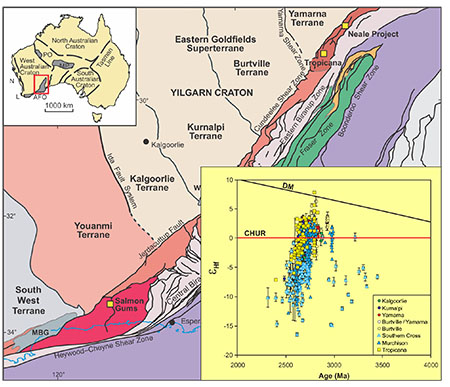
OUTCOMES AND IMPACT:
This program has combined time-constrained zircon Lu-Hf isotope data with other datasets to significantly enhance the understanding of crustal evolution in Western Australia. The results continue to further our understanding of several key areas of Western Australia, and feature prominently in new GSWA publications and journal articles. This is the first time in Western Australia that Lu-Hf isotope data obtained on this scale can be integrated with geological, geochemical, and newly acquired gravity, aeromagnetic, seismic and magnetotelluric data.
This program has produced numerous publications to date with the following notable “snapshot” highlights. Confirmation that the Biranup and Fraser Zones of the Albany-Fraser Orogen are autochthonous assisted in the delimitation of crustal blocks within the Yilgarn Craton. It also contributed to the understanding of the Mesoproterozoic Giles magmatic system in the Musgrave Province - one of the world’s largest super volcanoes, aiding the identification of a suspect terrane within the Capricorn Orogen, radically refining the geological model for the evolution of the Arunta Orogen. It produced evidence for links between the Warumpi and Aileron Provinces, defined a new basement component within the Musgrave Province and demonstrated reworking of Eoarchean crust during
Meso-Neoarchean magmatism in the Murchison.
Figure 1. Epsilon Hf evolution plot showing data from the Hercules Gneiss, Tropicana Zone, in comparison to terrains and domains of the Yilgarn Craton. Map is a simplified, pre-Mesozoic interpreted bedrock geology of the east Albany-Fraser Orogen and tectonic subdivisions of the Yilgarn Craton.
Another focus area was the high-grade Tropicana Zone, a newly defined Archean terrain at the north-eastern margin of the Yilgarn Craton within the Albany-Fraser Orogen (AFO), due to its significant Proterozoic gold endowment. The Hf isotopic signature of the Tropicana Zone zircon shows strong similarities to that from the Eastern Goldfields Superterrane of the Yilgarn Craton. This implies that the Tropicana Zone reflects a deeper crustal level of the Yilgarn Craton, exhumed and thrust nothwestwards onto the margin. In addition, we have observed that granulite-facies zircons have a less radiogenic Hf-isotope signature than the preserved pre-metamorphic zircon cores. Based on correlations with alpha dose, U and Th content and 176Hf/177Hf we suggest this reflects the preferential destruction and release of unradiogenic Hf from inherited zircon whereas the protolith zircon, with lower U and Th content, was more resistant to mobilisation during high-grade metamorphism. We note this situation may be a more general response of the Hf isotopic system, in which zircon grown in a more mafic melt is less likely to contribute to the metamorphic Hf reservoir than its felsic counterpart.
Postgraduate students involved:
David Mole
Published outputs:
CCFS Publications #61, 68, 78, 185, 209, 247, 256, 264, 265, 266, 267, 274, 275, 337, 346, 436, 441, 456, 497, 518, 547, 609, GSWA Reports 120, 122, GSWA Records 2011/23, 2013/9
Foundation Centre Technology Development programs
(Whole-of-Centre programs)
1. CAMECA ION MICROPROBE DEVELOPMENT: MAXIMISING THE QUALITY AND EFFICIENCY OF CCFS ACTIVITIES WITHIN THE UWA ION PROBE FACILITY
AIMS:
This program provided a dedicated Research Associate for the development of CCFS activities utilising the CAMECA Ion Microprobes at the Centre for Microscopy, Characterisation and Analysis (CMCA) at UWA, thereby increasing the capacity of the facility, enabling a higher degree of interaction and participation on projects, and allowing greater synergy with other CCFS node facilities. The research associate plays an integral role in experimental design, planning, sample preparation and the acquisition, processing and interpretation of data. This is fundamental to the generation of high-quality in situ elemental and isotopic data for a diverse range of projects and, as such, represents a significant investment into the overall success of the CCFS.
FINAL REPORT 2011-2014:
Recent successes in ARC LIEF funding have updated the electron microscopy facilities at CMCA, with the installation of a FEI Titan TEM, a FEI Verios XHR high resolution SEM, and Confocal Raman with AFM in 2014. In 2015-16, a Focused Ion Beam (FIB) platform for the preparation of TEM, NanoSIMS and atom probe samples will be installed.
The CMCA has also received funding for a new Cameca NanoSIMS 50L ion probe through CSIRO’s Science and Industry Endowment Fund (SIEF) via the National Resources Science Precinct (NRSP). The new instrument will be part of the tripartite Advanced Resources Characterisation Facility, along with a Cameca LEAP4000 Atom Probe to be located at Curtin University, and the in-house development of a MAIA mapping facility at CSIRO. The NanoSIMS 50L represents a considerable technological advance over the existing NanoSIMS, with a seven-FC/EM multi-collector array and a new oxygen ion source allowing high-resolution isotope measurements on geological samples.
The Ion Probe Facility has continued to contribute to various CCFS programs. These have included a wide range of topics, from the magmatic processes and crustal growth, the origin of ore deposits (O isotopes in zircon, E. Belousova and Y. Lu; S isotopes in sulfides, M. Fiorentini) and the exploration of redox processes in the deep Earth (Si and C isotopes in moissanite; J. Huang and W. Griffin). In addition, the NanoSIMS has also been involved in the measurement of element diffusion across mineral interfaces, trace element transportation along grain boundaries, and S isotopes (D. Wacey, M. Fiorentini).
High-precision isotope measurement with SIMS requires calibration against known standards to correct for instrumental mass fractionation between analysis sessions. This varies significantly between different materials, such that each new material analysed by SIMS necessitates the development of new standards. Standards are in constant development at CMCA and currently include pyroxene and olivine (O isotopes) as well as a range of Si-bearing materials (SiC, Si metal, silicates) for Si isotopes. Development continues on diamond (C isotopes), lawsonite, pyroxene, garnet and olivine (O isotopes), tourmaline and serpentine (B isotopes), pentlandite, pyrrhotite and chalcopyrite (S and Fe isotopes). The development of standards for unknown isotope systems aims to identify potentially new geochemical tools.
OUTCOMES AND IMPACT:
The Ion Probe Facility at CMCA was highly productive, contributing to a number of programs across the whole CCFS. Highlights include zircon analysis, sulfur isotope analysis, isotopic standard development and ultrafine resolution diffusion studies.
The analysis of oxygen isotope in zircon is a powerful tool to identify the magmatic origin of these crystals. E. Belousova and co-authors have conducted an integrated isotopic (U-Pb, Hf and O) study of zircon crystals from upper mantle rocks from the Tumut ophiolite complex. Their study shows that crust-derived zircons can be introduced into mantle rocks even after their obduction onto the continental crust, offering an alternative explanation for the presence of zircon in ultramafic rocks from ophiolite complexes (CCFS publication #519).
The ability to measure all 4 stable sulfur isotopes in sulfide minerals in situ makes the CAMECA IMS1280 one of the most powerful techniques available for S isotope analysis. The IMS1280 was used to analyse several sets of Precambrian sulfides in order to determine sulfur sources in deep time. A project led by CCFS SAC member James Farquhar (University of Maryland) measured S isotopes in 2.5 billion year old carbonate rocks from Brazil to investigate S sources in the Neoarchean ocean. The data revealed that bacteria were metabolising sulfate even when the ocean contained 1000 times less sulfate than today (CCFS publication #568).
Due to the strong ‘matrix effect’ inherent in SIMS analysis, each new material requires a chemically and isotopically homogeneous standard of known composition for calibration. In addition, the testing of new standards extends our capabilities into hitherto unexplored isotope systems. Recent development has included Si isotopes in silicates, SiC and Si metal, C isotopes in SiC, Zr isotopes in zircon crystals from different provenance. O isotope analysis in garnet is in constant development in order to cover the complex chemistry of this mineral. The development of a Cr-rich garnet standard is underway in collaboration with J. Huang, aiming to provide a better characterisation of mantle-derived garnets. The combined development of Li and O isotope measurements in olivine and clinopyroxene is also in progress.
The NanoSIMS proved once again that size does matter as a number of projects utilising the ultra-high spatial resolution and sensitivity to determine diffusion profiles across mineral interfaces. A study by Saunders et al., demonstrated how the ability to acquire high-resolution diffusion profiles could be used to better constrain the timing of volcanic processes on the timescale of days to years. Similarly, experimental studies on Ni and Co revealed that the activity of SiO2 has a significant effect on the diffusion rates of these elements in olivine from magmas with different compositions (CCFS publication #600).
Published outputs:
CCFS Publications #32, 74, 86, 106, 162, 225, 230, 232, 276, 275, 321, 337, 381, 362, 426, 437, 438, 439, 475, 489, 373, 485, 519, 541, 543, 553, 567, 568, 569, 570, 600, 601
2. FRONTIERS IN INTEGRATED LASER-SAMPLED TRACE-ELEMENT AND ISOTOPIC GEOANALYSIS
AIMS:
The program aims were to enhance the world-class facility for in situ isotopic and elemental analysis at GEMOC, in order to maintain Australia’s LAM-ICP-MS capabilities at international standards, and to advance beyond it in some aspects. The advances were based on femtosecond-laser sampling and the coupling of instruments for simultaneous analysis.
FINAL REPORT 2011-2014:
Planned innovations in the Geochemical Analysis Unit (GAU) at Macquarie University in the first term of CCFS were based on new instruments funded by ARC LIEF grants in 2010 (Q-ICP-MS, SF-ICP-MS and Femto-second laser) and 2012 (MC-ICP-MS). This new equipment was necessary for the development of ‘split-system’ techniques in which two mass spectrometers (MC-ICP-MS and ICP-MS) are connected to a common laser source for novel simultaneous measurement of geochemical parameters. The current status of this new instrumentation is as follows:
Quadrupole (Q)-ICP-MS: An Agilent 7700cx Q-ICP-MS was installed in June 2010, joining the existing stable of Q-ICPMS (3) and MC-ICPMS (2) instruments. In 2014 a second Agilent 7700cx was installed and co-located with one of the Nu Plasma MC-ICP-MS to establish the laser ablation split-stream infrastructure.
Femtosecond Laser Microprobe: A Photon Machines fs198 laser system was installed in June 2012. Due to recurring damage to optics, the beam delivery system was redesigned and replaced in January 2013 (and commissioned in July 2013).
SF-ICP-MS: A Nu AttoM high resolution sector field (SF)-ICP-MS was installed in January 2013. Activity on the Nu AttoM has concentrated on the transfer of in situ methodologies from the Q-ICP-MS with an emphasis on U-Pb geochronology of zircon.
MC-ICP-MS: An order was placed for a Nu Plasma II MC-ICP-MS in July 2014 and the instrument is due for delivery and installation in April 2015. This instrument will enable the development of the split-stream methods.
Development of split-stream methods was hampered by instrument performance issues; the main problem was the instability of the magnet on the Nu Plasma 005. Due to these instrumental issues a program was established to evaluate a range of new methods (proof-of-concept) and to refine and improve existing procedures in support of CCFS-funded research programs and to lay the foundations for the split-stream applications. Studies undertaken include:
[1] Evaluation of standard reference materials (zircon, fluorite, garnet, baddelyite, apatite, rutile, perovskite, PGM) for combined measurement using laser ablation ICP-MS and MC-ICP-MS.
[2] An investigation of the fundamental properties of nano- and femtosecond ablation processes in geological materials, focusing on laser-induced U-Pb isotopic fractionation in zircon.
[3] Development of new sample preparation methods for geochemical and isotope analysis in the GAU concentrated
on the separation and purification of radiogenic isotopes
(Rb-Sr, Sm-Nd and Lu-Hf radiogenic isotope systems) at ultra-low levels and/or small sample volumes and of Li and Mg isotope methodologies for a variety of rocks and minerals.
[4] Revision of GLITTER data reduction software was undertaken to enable the simultaneous treatment of combined trace element and isotope ratio measurements (including refinement of the propagation of uncertainties) and to support output from the Nu AttoM and Nu Plasma mass spectrometers and the Thermo Neptune and Qtegra.
OUTCOMES AND IMPACT:
The activities of the GAU continue to underpin the successful achievement of the goals of the research programs of CCFS and to promote cross-node interaction. The advancement of geochemical methodologies in the GAU plays a significant role in the creation of new research initiatives and to be a major factor in attracting new research collaborators to CCFS. Impact can be measured in terms of the development of innovative new methods and the application of these methods and can be demonstrated by the numbers of researchers and projects supported by the facility, and the communication of results in publications and reports. Access to the GAU facilities has synergised interaction with UWA and Curtin and has enabled researchers to come and undertake their analytical work, as well as spend important ‘face-to-face’ time discussing their projects with Macquarie colleagues. Since the commencement of CCFS in July 2011 the GAU has been used by 146 research staff and students, including those from the UWA and Curtin nodes of CCFS, other Australian institutions and international visitors. A total of 111 new collaborative projects utilised the facilities in the period July 2011 to December 2014, 46 of which have involved industry partners undertaking projects using the TerraneChron® methodology. The importance of the GAU to CCFS research output is further evidenced by ≥170 peer-reviewed CCFS publications (29% of all CCFS publications; ≥30 with Australian co-authors and ≥120 with overseas collaborators) containing data produced in the GAU. GEMOC also operated as one of the three national geochemical nodes for the NCRIS AuScope program between 2011 and 2014.
Postgraduate students involved:
Yuya Gao, Felix Genske, Nicole McGowan, Qing Xiong
Published output:
CCFS Publication #306
3. OPTIMISING MINERAL PROCESSING PROCEDURES: FROM ROCK TO MICRO-GRAINS
AIMS:
This program aims to optimise the liberation and recovery of the accessory mineral components from any type of rock for geochemical and geochronological analysis. This needed to overcome several major issues with these processes: breakage of grains, potential laboratory contamination, and the concentration and separation of extremely fine-grained phases. These problems are now substantially reduced using electrostatic pulse disaggregation, the use of disposable sieves, and hydroseparation procedures for ultrafine material.
FINAL REPORT 2011-2014:
The first selFrag instrument in Australia, installed in GEMOC in May 2010, uses electrostatic pulse disaggregation to break rock samples into their component phases and produces better liberation of mineral phases, especially accessory minerals, than conventional crushing procedures. Because disaggregation proceeds along grain boundaries, it greatly increases the proportion of unbroken grains. Disaggregation takes place inside a large Teflon-lined container, which is easily cleaned to prevent cross-contamination.
The selFrag is now routinely used for a wide variety of different rock types as the critical first stage in mineral separation procedures, representing a significant advance in method development. Since its installation, the primary application has been the extraction of zircon grains for U-Pb geochronology; in 2013 this accounted for > 90% of the samples processed. It has increased the yield of zircon crystals and the liberated crystals are virtually unbroken with very clean surfaces. This has enabled the dating of rocks with low zircon abundances and expanded the application of the U-Pb technique to mantle geochronology (e.g. chromitites, peridotites). Other new applications include the analysis of grain size and shape of phenocrysts and glass shards in volcanic rocks, the liberation of trace minerals from a range of rocks (e.g. alloys in mantle peridotites, platinum group minerals in chromitites), and archeological.
OUTCOMES AND IMPACT:
One of the most important products of the intensive development phase of selFrag is a handbook of experimental conditions for a wide variety of rock types. This is a valuable resource for users with all levels of experience and has contributed to the efficient operation of the facility. The cumulative expertise of the user group continues to grow and underlies the importance of the training program undertaken by all users as an important aspect of technology transfer.
The selFrag is the centrepiece of the facility for mineral separation at GEMOC, but for most samples it is just the first stage in the separation process. Further sample refinement is optimised by sieving using disposable plastic/nylon sieves to prevent contamination; heavy liquid mineral separation; magnetic/paramagnetic separation resulting in three output fractions: magnetic, paramagnetic and non-magnetic; micropanning for further concentration of phases with densities slightly different from their matrix; and hydroseparation of extremely fine-grained water-insoluble particles/grains. The hydroseparator has proved particularly useful to process ultra-fine selFrag material to concentrate rare accessory phases such as alloys in mantle peridotites and platinum group minerals in chromitites.
ECSTAR projects
The following projects are supported by ARC Post-Award funds allocated mid 2011 for early-career researchers. These are ARC ECSTAR Fellowships (Early Career Startup Awards for Research). The two appointees in 2011 were Dr José María González-Jiménez, Xuan-Ce Wang. Takako Satsukawa was appointed in 2012, Yongjun Lu in 2013 and Benedicte Abily in 2014.
ESTABLISHING THE LINKS BETWEEN PLATE TECTONICS AND MANTLE PLUME DYNAMICS: MESSAGE FROM THE LATE CENOZOIC LEIQIONG BASALTS IN SE ASIA
Xuan-Ce Wang: Supported by ARC CCFS ECSTAR funding and NSFC (National Science Foundation of China) Project grant (commenced 2011)
Theme 2, Earth Evolution, contributing to understanding Earth’s Architecture and Fluid Fluxes.
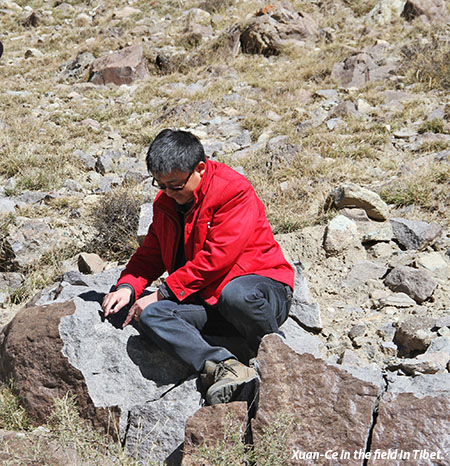
Late Cenozoic basalts in southeastern Asia have a unique role in testing whether mantle plumes and subduction are genetically linked because they occur above a seismically detectable mantle plume adjacent to major deeply subducted slabs. This projects aims to examine the petrogenesis of flood basalts located directly above this plume-like mantle structure. It uses a multidisciplinary approach, examining the characteristics of the basalts and their mantle source as well as the temporal-spatial variations in flood basalt geochemistry.
PROGRESS DURING 2014:
The most significant contribution of this project during 2014 was to provide a potential breakthrough hypothesis that links deep-Earth fluid cycling and large-scale intra-continental magmatism (such as continental flood basalts). In this year, we identified low-δ18O magma from the Late Cenozoic Chifeng continental flood basalts of East Asia. The low δ18O signatures coincide with clearly-recycled oceanic gabbro-derived signatures. Both of them correlated well with the inferred position of a stagnant Pacific slab within the hydrous mantle transition zone. Our study combines oxygen isotope with conventional geochemistry to provide the first evidence for an origin in the hydrous mantle transition zone. These observations lead us to propose an alternative thermochemical model, whereby slab-triggered wet upwelling produces large volumes of melt that may rise from the hydrous mantle transition zone. This model explains the lack of pre-magmatic lithospheric extension or a hot-spot track and also the arc-like signatures observed in some large-scale intra-continental magmas. Deep-Earth water cycling, linked to cold subduction, slab stagnation, wet mantle upwelling, and assembly-breakup of supercontinents, can account for the chemical diversity of many continental flood basalts.
Another significant contribution of this project during 2014 was to identify the possible disequilibrium-induced initial Os isotopic heterogeneity in a basaltic magma system. The Hainan-Leizhou lavas define good apparent Re-Os isochron correlations, yielding ages significantly older than their formation ages, and display remarkable correlations between the 187Os/188Os ratio and the reciprocal of the common Os concentration (i.e., 1/192Os). This indicates that the initial Os isotopic composition in a basaltic magmatic system was likely heterogeneous. We will further test whether the initial Os isotopic composition was heterogeneous or whether it had reached complete isotopic equilibrium.
Published output:
CCFS publications #16, 19, 24, 156, 159, 193, 195, 270, 297, 336, 338, 343, 347, 354, 369, 371, 397, 487, 540, 557
MAPPING THE DEFORMATION OF SUBCONTINENTAL LITHOSPHERE: THE EVOLUTION OF MICROSTRUCTURE AND FLUID-MELT-ROCK INTERACTION IN THE UPPERMOST MANTLE
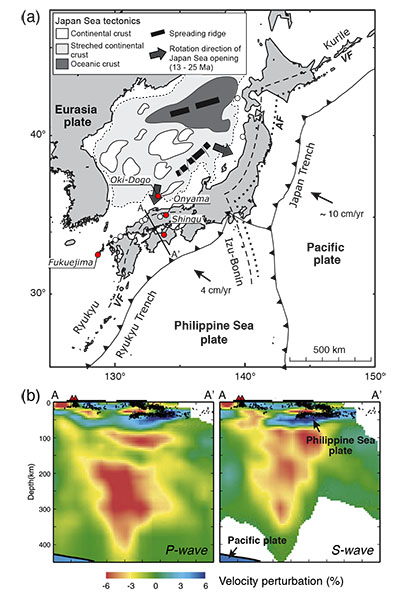
Takako Satsukawa: Supported by ARC CCFS ECSTAR funding (commenced 2012)
Themes 2 and 3, Earth Evolution and Earth Today, contributing to understanding Earth’s Architecture and Fluid Fluxes.
This project interfaces with Foundation Program 1, The TARDIS-E Program: “Tracking Ancient Residual Domains In the Silicate-Earth”.
The deep Earth water cycle is strongly coupled to plate tectonics, and the evolution of the uppermost mantle is commonly controlled by partial melting and/or refertilisation processes.
The amount of water carried into the deep mantle by descending oceanic crust is relatively small, but even trace amounts of water affect physical and chemical properties such as melting temperature, rheology, deformation mechanism and electrical conductivity.
This project mainly focuses on the rheology of the uppermost mantle, and investigates the relationship between deformation and fluid-melt-rock interaction to provide new constraints on the rheological properties of the lithospheric mantle. The development of a systematic approach combining microstructural analysis, the mapping of Crystallographic Preferred Orientations (CPO), water contents, numerical modelling of the seismic properties of individual samples, and geochemical analyses of xenoliths from different lithospheric levels and different degrees of melt-rock interaction. Previous work in GEMOC has focused on geochemical analysis; this project develops a new methodology for mapping ‘hidden’ microstructures by combining these approaches. This approach will provide new tools for the investigation of rock deformation, the rheological state of the mantle and the styles of mantle dynamics.
PROGRESS DURING 2014:
The uppermost mantle in back-arc regions is the site of complex interactions between partial melting, melt percolation, and fluid migration. The Japan Sea is one of the back-arc basins distributed around the western rim of the Pacific. Its floor is composed of oceanic crust, rifted continental crust and stretched continental crust. To constrain melt-fluid-rock interactions, we studied the microstructural development and consequences on the seismic anisotropies in peridotite xenoliths from the uppermost mantle of southwestern (SW) Japan (Fig. 1a).
The seismotectonics and volcanotectonics of SW Japan have been affected by subduction of the old Pacific and the young Philippine Sea slabs. Recent seismic observation reveals the three-dimensional P- and S-wave velocity structures of the uppermost mantle in SW Japan by using a large amount of high-quality arrival-time data recorded by the dense seismograph network on the Japanese Islands. It shows the existence of a large low-velocity anomaly below the Philippine Sea slab at least down to depths of 300km (Fig. 1b).

Figure 1. (a) Japanese island arcs and tectonic map of Japan Sea. VF, volcanic front; AF, aseismic front. Movement directions of Pacific and Philippine Sea plates are shown as solid arrows. The Japan Sea adjacent to NE Japan consists of oceanic crust, whereas the Japan Sea adjacent to SW Japan is underlain by continental crust (locally stretched). The peridotite xenoliths are from Oki-Dogo, Onyama, Shingu and Fukuejima, southwest Japan (red circles). Panel is modified after Satsukawa and Michibayashi (2014, Lithos). (b) Across-arc vertical cross section of P-wave and S-wave velocity perturbations (in %) along line A-A’ in (a) from Nakajima and Hasegawa (2007, EPSL).
The subduction zone along the Japanese Islands was chosen as a field laboratory to better characterise the deformation processes associated with fluid-melt-rock interaction. Four well-characterised suites of spinel peridotite xenoliths interpreted as sampling the mantle wedge were selected for this study: Fukuejima, Oki-Dogo, Onyama and Shingu are from SW Japan where the Philippine Sea plate is subducting under the Eurasian plate (Fig. 1a). Peridotite xenoliths were erupted (Fukuejima: 1 Ma, Oki-Dogo: 1-4 Ma, Onyama: 5-6 Ma) after the opening of the Japan Sea (13-25 Ma) except for Shingu (18 Ma), which may preserve features of the uppermost mantle prior to back-arc spreading.
Peridotite xenoliths from Fukuejima, Shingu and Oki-Dogo are spinel lherzolite, harzburgite, and wehrlite, whereas all Onyama peridotite xenoliths are spinel lherzolite. Peridotites have equigranular to porphyroclastic textures, with grain boundaries that range from triple junctions to smoothly curving boundaries. Some olivine grains are cut by pyroxenes. In most samples, orthopyroxene crystals have irregular grain boundaries, and fill interstices between the olivine grains.
Variable Cr# (0.1-0.5) of spinels, together with a limited range in olivine compositions (Fo90-Fo92) of Fukuejima peridotite xenoliths, indicate that xenoliths are derived from slightly to highly depleted residual mantle. The equilibrium temperature is relatively high (1070-1200 ºC), which suggests existence of a high geothermal gradient caused by thermal perturbation due to the injection of the hot asthenosphere and/or post-rifting uprise of mantle diapirs. Oki-Dogo peridotites have olivines with Mg# 0.86-0.93 and are enriched in LREE (i.e., flat REE pattern of clinopyroxene), interpreted as resulting from high melt-rock ratios. Onyama peridotites show uniform olivine (Fo89-Fo91) and spinel (Cr# = 0.1) compositions. The mineral chemistry of Shingu is variable. Shingu peridotites preserve a continuum of metasomatic events; (1) partial melting, (2) Fe-enrichment, (3) refertilisation with Ti and Al enrichment, and (4) enrichment in Al and rare earth elements.
Most of the olivine CPOs display a well-developed [100] concentration, and show dominantly (010)[100] and subsequently {0kl}[100] (Fig. 2a). Some of them from Fukuejima and Shingu samples show relatively strong concentration in [010] with a weak [100] girdle, indicating deformation in the presence of melt. Onyama peridotite xenoliths show a weak CPO pattern compare to other localities, which suggests they deformed under low shear strain.
Seismic properties of polycrystalline aggregates were computed by averaging the elastic-constant tensors of individual grains as a function of the CPO and modal composition of the sample (Mainprice, 1997). The P-wave velocity, S-wave velocity, the anisotropy of P-wave, and maximum S-wave anisotropies range from 8.22 to 9.36 km/s, 4.84 to 4.77 km/s, 2.5 to 12.6 %, 2.5 to 10.2 %, respectively (Fig. 2b). Onyama peridotites have significantly lower anisotropy due to their weak CPO.
Figure 2. (a) CPO or olivine. Lower Hemisphere, equal-area stereographic projections, contours at one multiple of uniform distribution. N is number of measured grains. (b) Variation in P-wave anisotropy and the maximum S-wave anisotropy calculated from CPO and modal composition of peridotite xenoliths.
Combined with petrological and microstructural observations, we argue that a suite of the peridotite xenoliths record a rare snapshot of flow in the uppermost mantle related to the initial stage of back-arc spreading. Geochemical characteristics reveal there was fundamental melt percolation both before and during back-arc spreading. It may indicate that asthenospheric flow and deformation occurred in the presence of small melt fractions. Results indicate the importance of the heterogeneous structure below the Philippine Sea slab with regard to the tectonics of SW Japan, and the preserved deformation during back-arc spreading could affect present-day mantle flow.
Published output:
CCFS publications #410, 560

 ARC Centre of Excellence for Core to Crust Fluid Systems
ARC Centre of Excellence for Core to Crust Fluid Systems